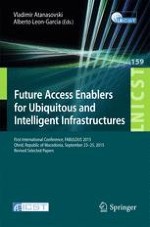2015 | Buch
Future Access Enablers for Ubiquitous and Intelligent Infrastructures
First International Conference, FABULOUS 2015, Ohrid, Republic of Macedonia, September 23-25, 2015. Revised Selected Papers
herausgegeben von: Vladimir Atanasovski, Dr. Alberto Leon-Garcia
Verlag: Springer International Publishing
Buchreihe : Lecture Notes of the Institute for Computer Sciences, Social Informatics and Telecommunications Engineering
